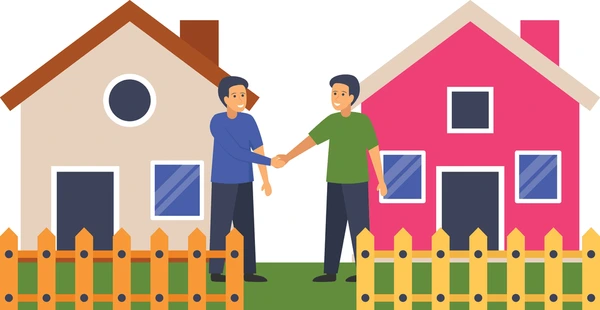
Property disputes between neighbors are disagreements involving land, structures, or usage rights that affect adjoining properties. These disputes often stem from unclear boundary lines, unauthorized construction, landscaping encroachments, or improper use of shared features such as driveways. Though some may appear minor at first, they can become ongoing legal battles if not resolved properly. Understanding the source of these conflicts is the first step in finding a peaceful and legal resolution.
Common Reasons for Property Conflicts
There are several common causes behind property conflicts. One of the most frequent issues involves disagreements about where the property line begins and ends. Even a few inches of encroachment can cause legal challenges if one neighbor builds a fence or places a structure beyond their legal boundary. Disputes also arise from overhanging tree branches, invasive roots, or when one neighbor performs landscaping that affects another’s property.
Shared driveways and access paths often spark disagreements regarding who is responsible for maintenance, snow removal, or improvements. Water drainage issues, where runoff from one yard floods another, also lead to intense disagreements. When one party feels their enjoyment or ownership rights are being interfered with, the situation can become legally complex.
The Importance of Staying Calm and Communicating First
When a property-related issue arises, emotions often run high. However, maintaining calm communication can prevent the situation from escalating. Many conflicts can be resolved with a respectful conversation before legal intervention is necessary. Approaching your neighbor with a cooperative mindset and clearly explaining your concerns can open the door to mutual understanding. Avoid accusations, threats, or demands, as these can lead to defensiveness and make resolution more difficult. Most neighbors prefer to avoid legal action and are open to compromise when approached calmly.
How to Review Legal Property Boundaries Properly
If your property dispute involves land boundaries, it is essential to verify the legal limits of your property. Start by reviewing your property deed, which contains a description of your lot’s dimensions. If you purchased the home with a mortgage, you may already have a survey on file from the closing process. In many cases, this document outlines the official boundary lines based on county or city records.
However, if the boundaries are unclear or if construction has occurred since the last survey, a current professional survey may be necessary. This ensures you have accurate documentation to support your claims and protect your rights.
When Should You Consider Hiring a Surveyor?
A licensed surveyor can help determine the exact lines of your property using up-to-date measurements and tools. If you suspect your neighbor has encroached on your land or you are unsure where your property ends, a legal land survey provides the evidence you need. This can be particularly helpful in fence line disputes, disagreements about shared land, or when applying for zoning permissions that require exact boundary verification.
A surveyor’s report serves as a neutral, legal record that holds weight in negotiations, mediation, and court proceedings. While surveys come with a cost, the investment can prevent years of confusion or conflict.
Legal Rights in Boundary and Fence Disputes
Boundary disputes are among the most common legal property issues between neighbors. Whether it involves a new fence built in the wrong place or a long-standing structure that overlaps property lines, knowing your legal rights is crucial. If your neighbor builds a fence on your side of the property line, you are typically within your rights to request its removal or adjustment.
However, local zoning laws, easements, and previous agreements can complicate the situation. For example, if the fence has been in place for many years and you never challenged it, adverse possession laws may allow your neighbor to claim part of your land legally. Seeking advice from a legal professional can help clarify your rights and the best course of action.
Handling Overhanging Trees and Root Encroachments
Tree and landscaping issues also cause frequent disputes. Branches that hang over your property can drop debris, pose safety hazards, or damage your home. Roots can crack pavement, damage foundations, or interfere with plumbing. Legally, property owners typically have the right to trim branches or roots that extend onto their land, as long as they do not trespass onto the neighbor’s side or cause permanent harm to the tree.
It is best to notify your neighbor before taking action. In some jurisdictions, removing more than what is necessary or damaging the health of the tree may result in liability. In cases where a tree poses immediate danger, such as a leaning trunk or dead limbs near power lines, local ordinances may support urgent removal for safety.
Shared Driveways, Easements, and Access Conflicts
Shared access areas, like driveways, private roads, or pathways, often lead to conflict. Disputes may arise over who maintains the area, whether one party can block access, or how improvements should be handled. If an easement is involved—a legal right to use part of a property—ownership may be divided between usage and legal title.
Resolving these issues often involves reviewing title documents, historical use, and easement agreements. In the absence of written rules, long-term usage patterns may set legal expectations. If you feel your access rights are being restricted or overused, documenting the situation and seeking legal interpretation of the easement agreement may be necessary.
Mediation: A Peaceful Approach to Legal Resolution
Mediation is a valuable tool in resolving property disputes without going to court. It involves a neutral third party who helps both sides reach a fair compromise. Mediation is generally faster, less expensive, and less emotionally draining than litigation. This option works especially well when both neighbors want to preserve their relationship while settling a dispute.
During mediation, each side has the opportunity to present evidence and explain their position. The mediator helps identify solutions that respect both parties’ rights and lead to a legally binding agreement. Many local governments and real estate boards offer mediation services for neighbor conflicts.
The Role of Documentation in Neighbor Disagreements
Documentation is essential when resolving any property dispute. Keep detailed records of every conversation with your neighbor, including dates and what was discussed. Take photos or videos showing the issue, such as fence placement, tree branches, or property damage. Save any texts, emails, or letters exchanged with your neighbor.
If you hire a surveyor or lawyer, keep copies of all reports and correspondence. Should the issue progress to court, this documentation will serve as critical evidence to support your claims. Without proper records, your case may rely on verbal accounts that are harder to prove.
When to Involve a Real Estate Attorney
While many disputes can be settled without formal legal action, there are situations where involving a real estate attorney becomes necessary. If your neighbor refuses to remove a structure encroaching on your land, damages your property, or violates written agreements, a lawyer can help protect your rights. Real estate attorneys can advise you on local laws, prepare legal notices, and represent you in mediation or court if needed.
In more complex cases involving multiple owners, easements, or zoning violations, legal guidance ensures that you follow the proper procedures. An attorney can also help you avoid mistakes that could weaken your position or create new liability.
Understanding Quiet Title Actions and Court Intervention
In disputes where ownership or property lines are unclear or contested, a quiet title action may be filed in court. This legal proceeding helps resolve claims of ownership and clears up conflicting interests in the property. A quiet title judgment provides a clear legal title and removes uncertainty over property rights.
Court intervention may also be necessary if your neighbor takes legal action against you or refuses to comply with agreed resolutions. In such cases, preparing a solid case supported by surveys, documents, and witness testimony is critical. Although court cases can be time-consuming and expensive, they may be the only option to enforce your property rights when peaceful solutions fail.
What to Expect During a Legal Property Dispute
Legal property disputes can involve multiple steps, including filing legal complaints, attending hearings, and submitting evidence. You may need to appear in civil court, provide documentation, and respond to formal legal arguments. The court may order mediation, conduct property inspections, or issue rulings about boundary lines, structures, or easements.
Expect the process to take time, especially if appeals are filed or multiple parties are involved. Having an experienced legal team and well-organized records can help you navigate the process with confidence and improve your chances of a favorable outcome.
How to Avoid Making the Situation Worse
When dealing with property conflicts, it’s tempting to take action without full legal knowledge. Avoid tearing down fences, cutting trees, or blocking access without confirming your rights. Acting without proper authority can result in trespassing claims, lawsuits, or even criminal charges. Instead, rely on communication, documentation, and legal consultation before taking physical action.
Do not involve other neighbors, post disputes online, or publicly shame the other party. These actions often make the situation worse and reduce the chances of peaceful resolution. Focus on resolving the issue legally, respectfully, and professionally.
Steps to Prevent Future Disputes with Neighbors
Preventing future property disputes starts with maintaining clear communication and boundaries. Make sure your property lines are well-documented and marked if necessary. When planning changes like fences, tree planting, or landscaping near the edge of your property, talk with your neighbor first. Transparency helps avoid misunderstandings and builds trust.
If you’re purchasing a new home, request an updated survey as part of the process. This can help you identify potential problems early and avoid inherited conflicts. Keep records of all property improvements, easement agreements, and any written neighbor arrangements for future reference.
Why Legal Clarity Matters Before Selling Your Property
Unresolved property disputes can become serious issues during a real estate transaction. Buyers are often cautious about purchasing property that involves ongoing legal conflicts or unclear boundaries. To avoid delays or canceled deals, resolve any property-related disagreements before listing your home.
Providing clear documentation of boundary surveys, easements, or legal resolutions can increase buyer confidence. A smooth and transparent transaction reflects well on you as a seller and protects the value of your property.
Knowing Local Zoning and Property Maintenance Rules
Every city or county has specific rules regarding fencing, land use, tree management, and property upkeep. Being aware of these regulations can help you stay compliant and avoid neighbor complaints. Before making changes to your property that affect shared spaces or visibility, check local zoning codes and permitting requirements.
Understanding the law helps you act within your rights while avoiding penalties. If a dispute arises, demonstrating that your actions align with local ordinances can strengthen your position and show that you acted responsibly.
Maintaining Long-Term Neighbor Relations After Resolution
Once a property dispute is resolved, it’s important to move forward with respect and maturity. Holding grudges or acting out can reignite tensions and undo progress. Acknowledge the resolution, whether formal or informal, and make an effort to keep communication open.
Sometimes, neighbors grow closer after resolving a conflict. A polite follow-up, kind gesture, or simple conversation can rebuild trust. Maintaining a good relationship not only improves your day-to-day living experience but also adds to the overall quality and stability of your community.




